The association of the “noble art of violeros, guitar makers and all kinds of stringed instruments” was founded in Madrid in 1761 by the violero Julián Fornieles and Lorenzo Alonso, and is the origin of the so-called Escuela de Madrid de Constructores de Guitarras.
Lorenzo Alonso and Marcos Antonio González were the examiners, who were in charge of examining the future members of this association.
In order to ensure the line and the brand, the most advanced disciple married his master’s daughter, of course, if there was one. This is how the guitar maker Manuel Muñoa married the daughter of Marcos Antonio González. And later Benito Campo inherited Manuel Muñoa’s workshop when he married his daughter.
Benito Campo was Francisco González’s teacher, and they worked together in their workshops on Majaderitos Street. In turn, Francisco González was the teacher of José Ramírez I, my great-grandfather.
Over the years, all the offshoots of the School created by Alonso y Fornieles in 1761 have disappeared, leaving only our own, which is currently represented by my nieces and nephews, Cristina and José Enrique, who are the fifth generation, and myself.
The beginning of Guitarras José Ramírez
My great-great-grandfather, the father of José Ramírez I, Domingo Ramírez de Galarreta y Martínez de Abad, was a very versatile man, at least in terms of his activities, as he was a landowner, horse breeder, builder and master carpenter.
As a carpenter, he belonged to the wood and cork guild, as did the guitar makers. And, as I understand it, he was friends with Francisco González. This, together with what must have been a marked fondness for everything to do with the guitar, was probably the reason why his first-born son, José, entered Francisco González’s workshop as an apprentice at the age of 12, in 1870. We think it is very possible that Domingo, given his many activities and his relationship with wood and guitar making, also built guitars, because his three sons, José, Antonio and Manuel, were all guitar makers.
We know that José was the teacher of his younger brother Manuel. We do not know, however, who was the teacher of Antonio, who had his guitar shop in Calle Mayor in Logroño.
In any case, José was the teacher of his eldest son José Ramírez II, and of other guitar makers who, when they became independent, obtained worldwide recognition, as is the case of Enrique García, teacher of another great guitar maker: Francisco Simplicio.
As for his younger brother and disciple Manuel, when he became independent he was also the teacher of other prestigious guitarists such as Domingo Esteso, Modesto Borreguero and Santos Hernández, who in turn trained other internationally renowned guitarists.
Manuel Ramírez, after working with his brother and maestro José, set up on his own. I can tell the anecdote about Andrés Segovia, and the fact that the guitar he gave him is currently on display at the MET in New York, together with the Hauser guitar that the maestro used after the last repair of the Manuel Ramírez, which was incorrect, and he could no longer play it.
And going back to José, he created the Tablao guitar at the request of flamenco guitarists (cafés cantantes and tablaos) and was in turn the teacher of his eldest son José Ramírez II.
José Ramírez II was the teacher of Manuel Rodríguez I, and of his eldest son José Ramírez III.
José Ramírez III and his revolution in the guitar world
José Ramírez III revolutionised the world of the guitar with his research, and formed a veritable school of guitar makers, as he taught the trade to no less than 30 disciples, among whom there were several who, after becoming independent, went on to achieve well-deserved recognition, such as Manuel Cáceres, José Romero, Teodoro Pérez, Manuel Contreras, Mariano Tezanos, Arturo Sanzano and Paulino Bernabé.
Among his disciples are my brother José Enrique and myself, although I was privileged to have had both my father and my brother, José Ramírez IV, as teachers.
There is so much to tell about my father, José Ramírez III, that it would be too much to describe it all here. In short, and apart from his research into templates, varnishes, internal structure, draught, weight and measurements of the bridge, and more, I can tell:
- His meeting with Andrés Segovia
- He discovered red cedar for the tops.
- His determination to get Segovia to play a Ramírez again.
- On the Australian tour, where Andrés Segovia was playing for the first time one of his own guitars, and from then on he continued playing the guitars of our firm.
- 10-string guitar, with the collaboration of Narciso Yepes, its design and study of the balanced proportions in its construction… all this served as a model for other guitar makers who later built this type of guitar.
- 8-string guitar at the request of José Tomás.
- Flamenco guitar for Víctor Monge Serranito, also used by other great flamenco guitarists such as Manolo Sanlúcar and Paco de Lucía.
- The Chamber guitar achieves a clear sound by separating the notes in a way that makes it an ideal guitar for recordings.
- Romantic Guitar, was a revolutionary design for this type of instrument, as he applied measures that gave it a powerful sonority, as opposed to the intimate sound of the historical romantic guitars.
And I am aware that I am leaving quite a few things out.
We continue to perfect guitar construction
My brother, José Ramírez IV, continued our father’s work and dedicated himself to perfecting it, creating a more stable construction system, strictly maintaining our tradition of craftsmanship, and managing to make our guitars very comfortable to play.
- Developed a line of studio guitars with our design.
- Electrified cutaway guitar.
As for me, as I have already mentioned, my teachers were my father and my brother when I entered the workshop in the 1970s. As it was supposed to be a man’s trade, I was not supposed to learn to build guitars, but infected from an early age by my father’s passion for the guitar, and taught by listening to him talk about it, I always wanted to learn the trade, so I finally did, and I did my apprenticeship in five years.
I then left for about two years to pursue other activities and returned in ’88 to run the business with my brother. Together we restructured the workshop and returned to the original concept of a small workshop with very limited production.
Twelve years later, when my brother died, I took over the business, and I was experimenting with the golden section, with the chambered guitar designed by my father, with new materials such as nómex, and developing the Auditorium guitar.
I reissued the guitar by Manuel Ramírez that belonged to Andrés Segovia and which is on display at the MET, as I mentioned above. I introduced the semi-professional guitar and new studio guitar designs.
And my favourite disciples are my nieces and nephews, Cristina and José Enrique, who are currently taking over the business with my collaboration. They have taken initiatives such as reproducing the Tablao guitar of their great-great-grandfather José Ramírez I, and more simplified, totally handcrafted guitars such as the Preludio and the Sencilla.
Otherwise, we remain committed to serving guitarists, who are our fundamental guide as we continue to evolve and innovate.
I must thank the researchers Pablo de la Cruz, Xosé Crisanto and José Juan Fernández for some of the valuable and revealing information that has been completing my family’s history and which I am presenting here. Likewise, José Juan Fernández, through his research, found the only descendant of Antonio Ramírez de Galarreta, his great-granddaughter Maribel Mirallé, and put us in contact, which was a source of joy for her, my nephews and me.
Article written by Amalia Ramírez.


